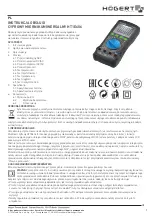
2
–
Functional Design
NetXpress LX & CM-30R Installation & Operation Manual
Version 1.1
GatesAir, Inc.
2-9
Intraplex Products
2.3.4
SNMP Communities
An SNMP community is a group of hosts that you can manage as a distinct group using SNMP. You
must use a community name for all SNMP conversations to take place. You can use the same name for
a read-only community and a read-write community, or you can specify two different names to restrict
write-access to the system.
2.4 NetXpress LX QoS
Quality of Service (QoS) / Class of Service (COS) mechanisms can reduce flow complexity by mapping
multiple flows into a few service levels. Network resources are then allocated based on these service
levels and flows can be aggregated and forwarded according to the service class of the packet.
2.4.1
COS Levels for Stream Data
The class of service (COS) level for a stream is established when the stream is created. The NetXpress
LX system offers four COS levels (high, normal, medium, low) for stream data (Section 4.3.5.1
–
Stream Creation
). The classes are based on service priority; the higher the priority, the more
immediate the handling of the stream. For example, program audio is critical in many operations, so
when a stream is configured for program audio, you designate a high class of service level for that
packet stream. Conversely, a voice circuit might be considered less critical to operations, so you might
specify a lower COS level.
2.4.2
TOS Byte Marking for Outbound Stream Packets
In an IP network, all IP packets contain a field in the IP header called the Type of Service (TOS) byte.
The value of the TOS byte tells the network what quality of service needs to be applied to the packet.
You can define what the value of the TOS byte field should be for each of the four classes of service
supported by the NetXpress LX system for stream packets. The system places the appropriate TOS
byte value corresponding to the COS provisioned for a stream in every outbound data packet for that
stream (Section 4.3.4.3
–
Class of Service
). Since TOS byte value can be set to any value per class of
service, the NetXpress LX system can operate in networks using Differential Services (DiffServ) QoS
and networks employing the standard TOS interpretation for QoS.
2.4.3
User-Defined TOS Byte Setting for Outbound SNMP and HTTP
Packets
In addition to supporting the TOS marking for stream data, the NetXpress LX system allows you to
configure the TOS byte value placed in all outbound SNMP and HTTP packets. Therefore, SNMP
management traffic and Web interface traffic to be handled in the network with a different class of
service than other packets.
2.5 NetXpress LX Internal TDM Busses
The NetXpress LX IP multiplexer uses two TDM busses to support data transfer for audio channels.
These busses (TDM Bus 1A and TDM Bus 1B) can be configured to operate in T1 or E1 mode.
Note:
Both A side and B side busses operate in the same TDM bus mode; you cannot have one using
T1 bus mode and one on E1 bus mode.
When set for T1 mode, the TDM busses support robbed-bit signaling. When set for E1 mode, the TDM
busses in the NetXpress LX system support CAS (channel associated signaling) and CCS (Common
Channel Signaling). With CAS signaling, time slot 16 is always reserved for telephone signaling. The
data rate is fixed at 1.544 MHz (T1 mode) or 2.048MHz (E1 mode). In E1 mode, you can enable or
disable (CAS) signaling.
















































